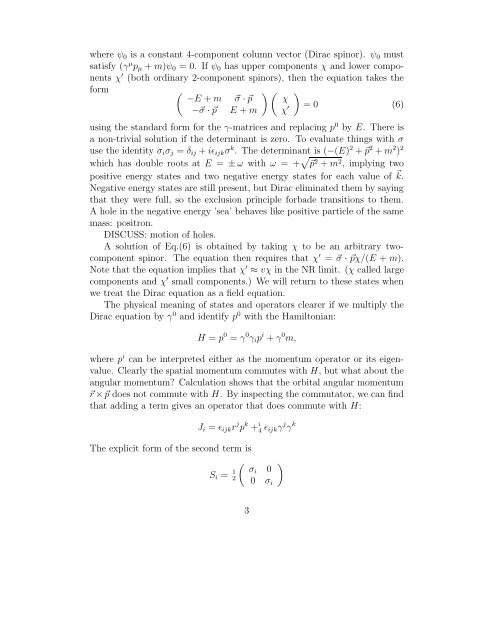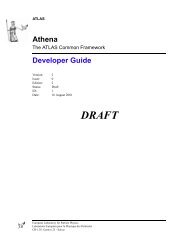0.1 Klein-Gordon Equation 0.2 Dirac Equation
0.1 Klein-Gordon Equation 0.2 Dirac Equation
0.1 Klein-Gordon Equation 0.2 Dirac Equation
Create successful ePaper yourself
Turn your PDF publications into a flip-book with our unique Google optimized e-Paper software.
where ψ 0 is a constant 4-component column vector (<strong>Dirac</strong> spinor). ψ 0 must<br />
satisfy (γ µ p µ + m)ψ 0 = 0. If ψ 0 has upper components χ and lower components<br />
χ ′ (both ordinary 2-component spinors), then the equation takes the<br />
form ( ) ( )<br />
−E + m ⃗σ · ⃗p χ<br />
−⃗σ · ⃗p E + m χ ′ = 0 (6)<br />
using the standard form for the γ-matrices and replacing p 0 by E. There is<br />
a non-trivial solution if the determinant is zero. To evaluate things with σ<br />
use the identity σ i σ j = δ ij + iɛ ijk σ k . The determinant is (−(E) 2 + ⃗p 2 + m 2 ) 2<br />
which has double roots at E = ± ω with ω = + √ ⃗p 2 + m 2 , implying two<br />
positive energy states and two negative energy states for each value of ⃗ k.<br />
Negative energy states are still present, but <strong>Dirac</strong> eliminated them by saying<br />
that they were full, so the exclusion principle forbade transitions to them.<br />
A hole in the negative energy ’sea’ behaves like positive particle of the same<br />
mass: positron.<br />
DISCUSS: motion of holes.<br />
A solution of Eq.(6) is obtained by taking χ to be an arbitrary twocomponent<br />
spinor. The equation then requires that χ ′ = ⃗σ · ⃗pχ/(E + m).<br />
Note that the equation implies that χ ′ ≈ vχ in the NR limit. (χ called large<br />
components and χ ′ small components.) We will return to these states when<br />
we treat the <strong>Dirac</strong> equation as a field equation.<br />
The physical meaning of states and operators clearer if we multiply the<br />
<strong>Dirac</strong> equation by γ 0 and identify p 0 with the Hamiltonian:<br />
H = p 0 = γ 0 γ i p i + γ 0 m,<br />
where p i can be interpreted either as the momentum operator or its eigenvalue.<br />
Clearly the spatial momentum commutes with H, but what about the<br />
angular momentum? Calculation shows that the orbital angular momentum<br />
⃗r × ⃗p does not commute with H. By inspecting the commutator, we can find<br />
that adding a term gives an operator that does commute with H:<br />
J i = ɛ ijk r j p k + i 4 ɛ ijkγ j γ k<br />
The explicit form of the second term is<br />
( )<br />
S i = 1 σi 0<br />
2<br />
0 σ i<br />
3
















